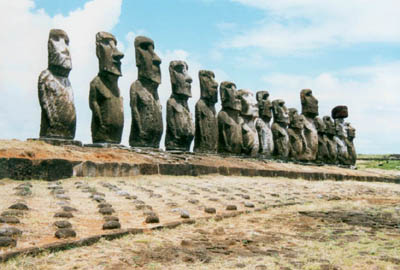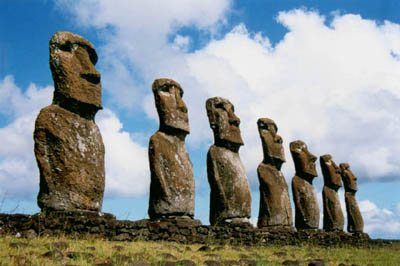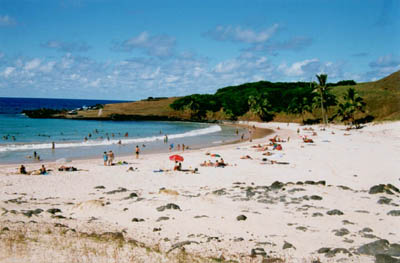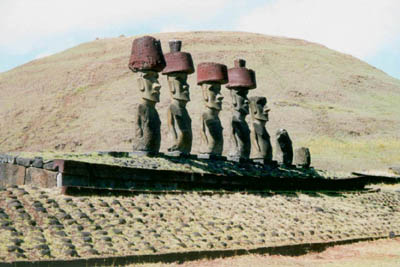7 February 2003: Papeete, Tahiti, French Polynesia
Subject: Chile (2)
Well I have now arrived in Tahiti, though I won't be staying for long as it seems to be the most expensive place on earth. Also I won't be typing much now as all the keys on this keyboard are in the wrong places!
Easter Island (Rapa Nui)
Well what can I say? You have all seen the TV documentaries about Easter Island and its extraordinary mysterious history. I was there for four days. On the first day I walked up to Rano Kau, the volcanic crater that makes up the bottom third of the island and saw the Orongo ceremonial village where, in the post-moai phase, they had an annual competition to be the first to collect a Sooty Tern egg from an adjacent islet (the "Birdman" cult). Then for the next two days I hired a bike.
First I cycled along the length of the south coast. The roads are practically all paved and the gradients gentle; it was ideal for cycling. This road first leads past one Vinapu, an Ahu (statue platform) whose especially good stonework makes some think that it was influenced by contact with the Incas. Then at the end of the road there's Rano Raraku, the volcano crater quarry where the moai statues were carved, with dozens and dozens of them still half finished stuck in the bedrock and other finished ones abandoned and buried up to their necks half way down the slope. Finally there is Tongariki, the "15 Maois" Ahu where the statues were the only ones still naturally upright until they were flattened by a tidal wave in 1960. A Japanese company put them back up a few years ago and they look really spectacular.

Then I returned to the town via Runa Pau, the quarry where they got the red stone for the "topknots", and seven more re-erected moai statues at A Kivi.

Further down the road I found a lava tube cave where some prehistoric people had lived, and I couldn't resist the urge to wander into it despite having no light!
On my second day with the bike I did the other, longer, road to the North of the island (18km). At the end there is an excellent beach (where I managed to get a bit sunburnt - silly me!) and some more re-erected Maois to see, these ones being some of the few to have their topknots in place.


I was lucky enough to be there during their annual cultural festival. So after spending the daytime cycling around looking at the ancient archaeology I could spend the evenings watching the locals singing and dancing. It wasn't easy to work out what it was all about as it was mostly in Rapanui, but it was spectacular to watch. The first evening was the opening ceremony with lots of tri- or quadrilingual speeches followed by a re-enactment of some ancient ceremony. On the second evening they held a traditional Rapa Nui wedding, and on the third a sort of talent contest. I think that just about every resident of the island took part in something or other, either singing in a choir or dancing or playing an instrument. The one word of the Rapanui language that I will remember is "'opa 'opa". Can you guess what it means? It's an accordian!
The population of Easter Island is about the same as Lytchett Matravers, so it is interesting to see how well they manage being so isolated. The Chilean government is very proud of its one bit of "empire" and pumps lots of subsidy into the island, and apparently the residents get a free flight to Santiago each year. This presumably helps to integrate them with the rest of the country, but culturally they still have a lot more in common with the rest of Polynesia than they do with the Latin Americans. They seem to be reasonably well off, though tourist numbers and accomodation prices seem to be quite low. It was definitely worth spending a few days there.